Indonesia's Steel Production Increases Year by Year
According to data compiled by SMM from the World Steel Association (WSA), Indonesia is one of the major steel producers in Southeast Asia. In 2024, Indonesia's crude steel production reached 17 million mt, an increase of 0.9% from 16.8 million mt in 2023, ranking 14th globally.
Table: International Crude Steel Production and Rankings, 2023-2024
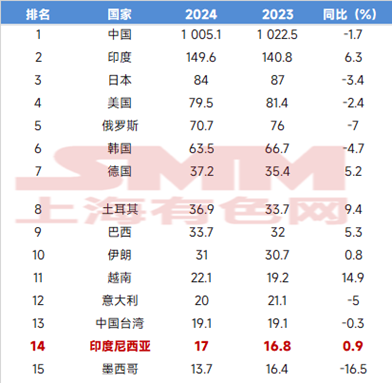
Source: WSA, SMM
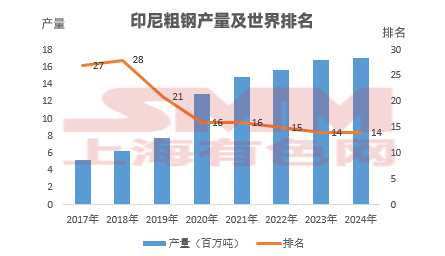
Source: WSA, SMM
In the past, Indonesia's steel production was far below its steel demand, requiring a large portion of its steel needs to be met through imports. However, in recent years, with the commissioning of new capacities, Indonesia's steel production has been steadily increasing.
Currently, there are approximately 124 steel companies in Indonesia, mainly located on Java Island, Sumatra Island, Kalimantan Island, and Sulawesi Island, with the majority concentrated on Java Island. Most of these companies are small-scale enterprises. The largest steel company in Indonesia is Krakatau Steel, a state-owned enterprise with a crude steel capacity of 5.9 million mt, accounting for more than half of Indonesia's crude steel capacity.
Table: Top 10 Steel Companies in Indonesia and Their Main Products

Source: WSA, SMM
Rapid Economic Development in Indonesia Drives Significant Growth in Steel Demand
With the continuous growth of Indonesia's economy, the demand for steel across various industries has been steadily increasing. The development of industries such as infrastructure, real estate, automotive, electronics, and home appliances heavily relies on steel. For instance, increased government investment in infrastructure construction will boost steel demand; the booming real estate market requires large amounts of steel for construction; the development of the automotive industry drives the demand for automotive steel; and the growth of the electronics and home appliance industries also necessitates steel as a raw material.
The construction industry is the primary driver of steel demand growth in Indonesia, accounting for 78% of the country's total steel consumption. Due to Indonesia's numerous ongoing infrastructure projects and growing housing demand, its construction industry performed well during the 10 years prior to the outbreak of the pandemic.

Source: WSA, SMM
The current Indonesian government places great emphasis on infrastructure development. Since 2015, the government has allocated a significant portion of its annual budget to infrastructure projects. As part of Indonesia's "2020-2024 National Medium-Term Development Plan (RPJMN)," the government is committed to developing various transportation infrastructure projects to support economic growth. Currently, Indonesia has at least 41 strategic priority projects, with a total indicative fund of $426 billion by 2024.
The automotive industry is also a key driver of steel demand growth in Indonesia. In the "Making Indonesia 4.0" industrial revolution roadmap formulated by the Indonesian government, the automotive industry is identified as one of the five priority manufacturing sectors. Currently, Indonesia has become the second-largest automotive manufacturing hub in ASEAN, after Thailand. Therefore, its automotive industry has a promising development outlook. Indonesia's automotive development is primarily driven by foreign direct investment, particularly from Japan, which accounts for 75% of the total foreign direct investment in the country's automotive sector.
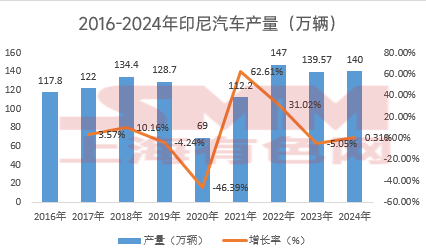
Source: Indonesian Automotive Industry Association, SMM
The Indonesian Government Actively Develops the Domestic Steel Industry to Reduce Import Dependency
Table: Major Steel Importing Countries, 2023
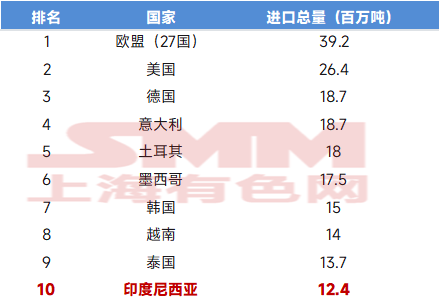
Source: WSA, SMM

Source: OEC, SMM
Indonesia's steel production is far below its steel demand, requiring a large portion of its steel needs to be met through imports, making Indonesia one of the world's major steel importers. In 2023, Indonesia's steel imports amounted to $1.13 billion, with the main import sources being China, Japan, Oman, South Korea, and South Africa.
To promote the development of its domestic steel industry, the Indonesian government has implemented a steel import quota system. This system sets specific import quotas for importers, allowing only a certain quantity of steel to be imported within a specified period. The quotas are determined based on domestic demand and the government's development plans for the steel industry and are adjusted annually according to actual conditions.
Applying for Indonesia's steel import quotas involves multiple steps, including obtaining a recommendation letter from the Ministry of Industry, submitting the recommendation letter online to the Ministry of Trade, submitting relevant documents to designated institutions, and paying inspection fees. It is worth noting that, as the steel import quota system aims to protect the domestic steel industry, the application process may face policy restrictions, such as higher tariffs and stricter import application reviews. Therefore, trade and construction companies should thoroughly understand Indonesia's relevant policies and regulations before applying to ensure a smooth application process.
The following is anti-dumping investigation information compiled by SMM based on the International Trade Relief Network:
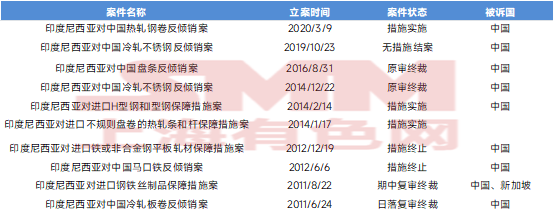
Source: China Trade Relief Information Network, SMM
China Is the Main Destination for Indonesian Steel Products
In 2023, Indonesia ranked 14th among the world's largest steel producers. Although not at the forefront, this position indicates Indonesia's significant and growing production capacity. In H1 2024, Indonesia was a net exporter of semi-finished steel products, with exports reaching 3.076 million mt, up 84.3% YoY. This data highlights a significant improvement in Indonesia's semi-finished steel production capacity.
In H1 2024, Indonesia's finished steel exports amounted to 3.044 million mt, up 5.4% YoY. The Indonesian government has also actively encouraged the steel industry through various incentives and investment promotion policies, aiming to increase domestic production and exports.
Table: Major Steel Exporting Countries, 2023
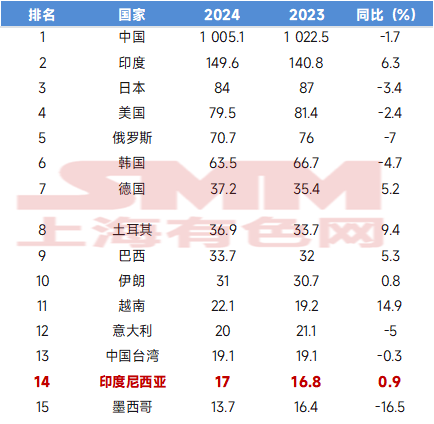
Source: WSA, SMM
In 2023, Indonesia exported $2.68 billion worth of steel. The main destinations for Indonesia's steel exports were China, Taiwan, China, India, Vietnam, and Malaysia. The fastest-growing markets for Indonesia's steel exports from 2022 to 2023 were India, Mexico, and Cameroon.

Source: OEC, SMM
China is Indonesia's largest market and the largest source of imports for its steel products. Since 2018, China has been the primary export destination for Indonesian steel products and has continued to grow. However, the Indonesian Iron and Steel Industry Association also reminds Indonesian steel producers to closely monitor the development of potential export markets outside China to improve export performance, such as Taiwan, China, India, ASEAN countries, and EU countries.
The following is anti-dumping investigation information compiled by SMM based on the International Trade Relief Network:

Source: China Trade Relief Information Network, SMM
Supply and Demand Outlook for Indonesian Steel
Among the ASEAN member countries, Indonesia is the largest in terms of land area, population, and GDP. Specifically, Indonesia's GDP accounts for more than one-third of ASEAN's total GDP, and its population accounts for 41% of ASEAN's total population. Additionally, Indonesia is the world's largest archipelago nation, with a population of 276.36 million, ranking fourth globally.
With optimistic steel demand prospects driven by economic growth through 2050, under the baseline scenario, the Indonesian Iron and Steel Industry Association predicts that the country's steel consumption could reach 22 million mt in 2025 and 125 million mt by 2050. To meet this demand, Indonesia's steel industry is expected to add 130 million mt of steel capacity, increasing to 156 million mt by 2050, with a capacity utilization rate of 80%.
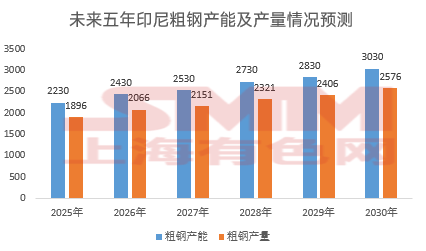
Source: WSA, SMM
According to data released by Indonesia's Central Statistics Agency, Indonesia's actual GDP grew by 5.03% YoY in the first three quarters of 2024, slowing by 0.02% compared to the same period last year. Bank Indonesia (BI) predicts that despite challenges from geopolitical and global market fluctuations, Indonesia's economy will remain resilient, with GDP growth expected to range from 4.8% to 5.6% in 2025.
Table: Infrastructure Data Projections for Indonesia, 2026-2030

Source: Indonesia Statistics Agency, SMM
Amid Indonesia's strong economic growth momentum, the country's infrastructure construction and manufacturing sectors are thriving, contributing significantly to steel demand. Among these, the construction and automotive manufacturing industries stand out. The Indonesian government places great importance on infrastructure development, which requires large amounts of steel. The highly anticipated capital relocation project in Indonesia is expected to cost $32.4 billion, with the first phase alone requiring 500,000-700,000 mt of steel. The new capital city, Nusantara, will be built 800 miles from Jakarta and will be the largest infrastructure project in the country's history. The chairman of the Indonesian Iron and Steel Industry Association stated that the development of the city will require 9.5 million mt of steel. He estimates that the first phase of the project will use 500,000 to 700,000 mt of steel, with an additional 1 million mt required for each subsequent phase. The Indonesian Iron and Steel Industry Association is working with the Ministry of Public Works and Public Housing to ensure the supply of the large quantities of steel needed for the new capital's construction. Indonesia's manufacturing sector is also expected to show stronger growth. By unlocking domestic market potential, leveraging natural resource advantages to develop the EV industry, and increasing export orientation, Indonesia's automotive industry will become another key driver of steel demand growth. As a result, Indonesia is set to become an emerging ASEAN country driving steel demand growth in the region.



